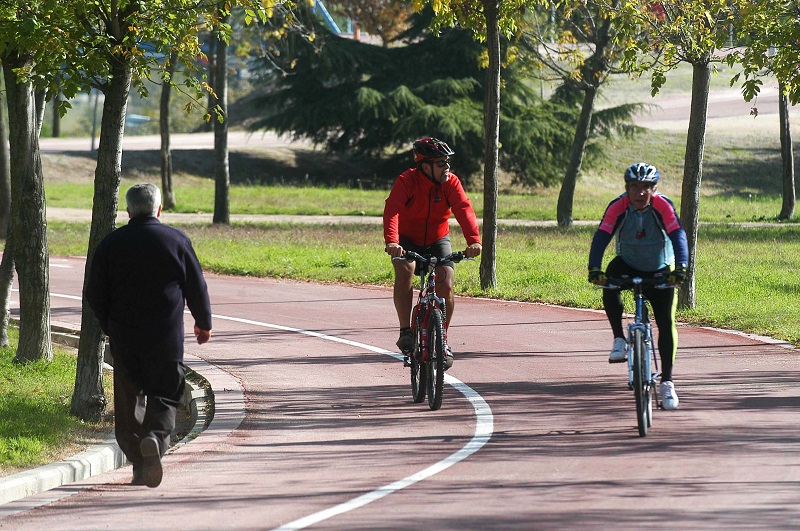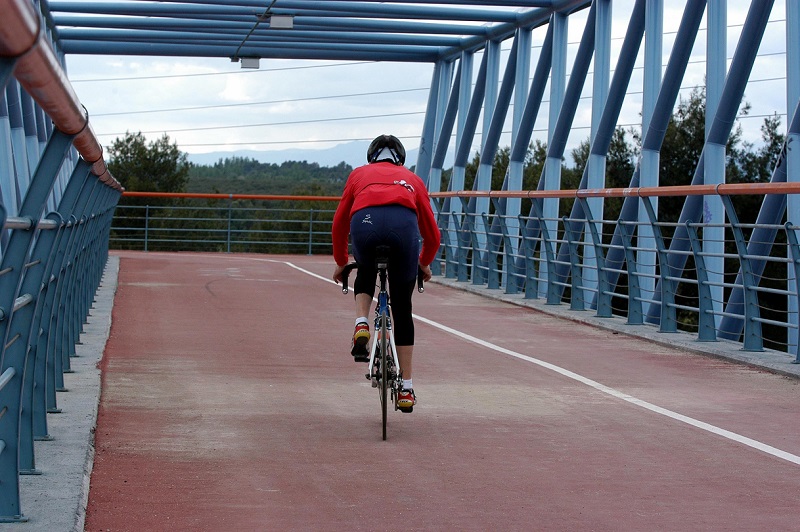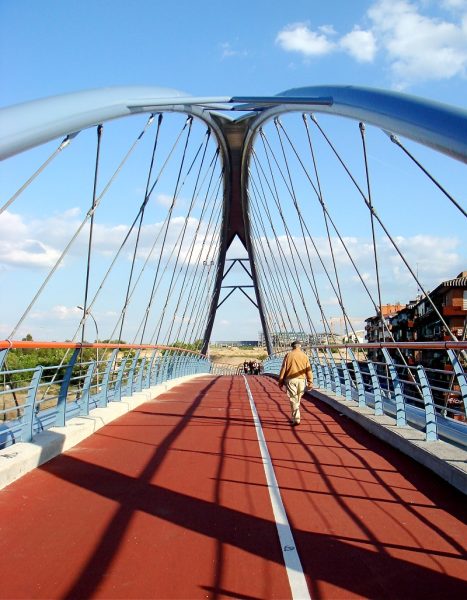11 August 2020
for Madrid Nuevo Norte

The 64-kilometre long Green Cycling Belt connects Madrid’s outlying neighbourhoods with large parks such as Lineal del Manzanares, Juan Carlos I or Casa de Campo.
Although thousands of cyclists have used these cycleways for leisure and sports since 2007, it has also served to promote sustainable mobility.
This extensive cycling infrastructure is currently under renovation to improve accessibility and lighting. It will be fully open again in the summer of 2021.

For over a decade, the Green Cycling Belt has been the city’s most iconic cycling infrastructure. Officially referred to as AVC-64, this cycleway encircles Madrid’s urban core, running mostly along the M-40 ring road, connecting the outlying neighbourhoods. It also makes it easier for cyclists to access the “green lungs” of the city, including Juan Carlos I Park, Casa de Campo or Parque Lineal del Manzanares. It is divided into six sections, taking the six radial roads (A-1 to A-6) that criss-cross the city as reference. The cycling belt runs through nine of the 21 districts: Fuencarral-El Pardo, Hortaleza, San Blas, Moratalaz, Puente de Vallecas, Usera, Carabanchel, Latina and Moncloa-Aravaca.
The Green Belt is currently being redesigned. It will soon reopen with a better and more accessible layout, safe for everyone.
From the outset, Madrid’s cycling enthusiasts embraced this cycleway with its rest areas, milestones and uninterrupted itinerary. Indeed, they coined the term “anillada” to describe cycling meetups along its distinctive deep-red lanes. Although it is primarily used for sports and leisure activities, the infrastructure also encourages cycling as a sustainable means of transport, as the cycleway passes through many neighbourhoods which until then were isolated from each other.
The belt officially opened in 2007, following the completion of significant engineering works that involved the construction of 20 walkways, bridges and tunnels. These elements helped to overcome natural or artificial obstacles, such as the railroad tracks or express throughways, that kept some neighbourhoods isolated from others.
“The Green Belt was an excellent idea for encouraging the use of bicycles in Madrid and in the whole region”, said José Almagro Valero, Secretary-General of the Madrid Cycling Federation (FMC). “Most importantly, it provided a sense of safety to many people who feared cycling on roads with vehicles”, he emphasised. According to Almagro Valero, this well-lit and signposted route around the city was a major step toward making cycling the favourite sports in Madrid. According to the FMC’s estimates, some 50,000 Madrilenians cycle regularly.

Cyclists coexist with walkers and runners along the Green Cycling Belt. Each group has its own lane. Photo: madrid.es
The Green Cycling Belt has established itself as the capital’s friendly route par excellence for cyclists. It takes about four and a half hours to complete the itinerary at 15 km/h; although faster cyclists can complete it in significantly less time. Given that it is a very busy cycleway, Almagro Valero discourages its use by professional cyclists for training at speeds above 25 or even 28 km/h. In these cases, he suggests its use only to access more suitable routes for training, such as the Colmenar cycleway.
It should not be forgotten that the Green Belt is used not only by cyclists. A significant part of the belt is also popular with walkers, who have their own lane. Many runners and groups of people walk through the different sections, especially on weekends, alongside the bicycles.
Roberto Mena, a cycling enthusiast and owner of LoboBike, a store, workshop and cycling club located in the Las Tablas neighbourhood, often uses the Green Cycling Belt. In his view, it is important to recognise “its contribution as an alternative means of transport, not just to have a good time. Many people use it daily to cycle to work. For instance, they take their bikes on the commuter train to Chamartín Station, and then cycle the last part of their route”. This is the practical use that was intended in the original design. Indeed, the Green Cycling Belt passes next to twenty Metro, six commuter train and three light rail stations.
Mena believes that the use of the Green Belt will be further boosted when it is linked to other cycleways leading into Madrid that run through neighbourhoods along the path. “This would greatly contribute to fostering its use for daily commutes”, he stated. The Madrid Nuevo Norte project includes connections to the Fuencarral and Las Tablas districts. This would help regenerate a 300-hectare area in the north of the capital. The 13 kilometres of cycleways envisaged in the project will connect with the Green Belt at two points, linking the area with Monte de El Pardo and all neighbourhoods surrounding the project.

Both the design and the blue and orange bridges and walkways of the Green Belt make them easily recognisable. Photo: Álvaro Ibáñez.
A few further months will be needed to enjoy the entire Green Belt again. The City Council is undertaking refurbishment works throughout the whole route that should be completed in the summer of 2021. The works focus on accessibility, in particular, for blind people, as well as new pavement and LED lighting. The cycleway will also be equipped with new urban furniture. Seventeen (17) areas have been identified where improvements could be made, including widening and adapting the route.